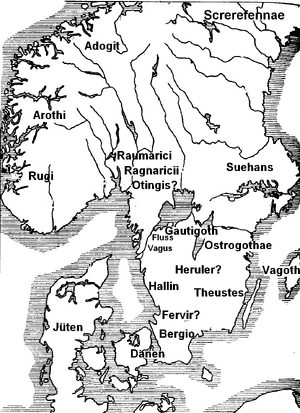Ahelmil
| Author:Laxman Burdak, IFS (R) |
Ahelmil were a Germanic tribe living in Scandza (Scandinavia) mentioned by historian Jordanes in his work Getica.
Variants
Jat clans
History
It is mentioned as a Gothic nation by Jordanes in his work Getica from about 551 AD: "Sunt quamquam et horum positura Granii, Agadii, Eunixi, Thelae, Rugi, Harothi, Ranii." (Getica, III:24)
Inhabitants of Scandza
Jordanes names a multitude of tribes living in Scandza, which he named a womb of nations (loosely translated), and says they were taller and more ferocious than the Germans (archaeological evidence has shown the Scandinavians of the time were tall, probably due to their diet). This is a strong evidence that they were Jats. The listing represents several instances of the same people named twice, which was probably due to the gathering of information from diverse travellers[1] and from Scandinavians arriving to join the Goths, such as Rodwulf from Bohuslän.[2] Whereas linguists have been able to connect some names to regions in Scandinavia, there are others that may be based on misunderstandings.[3]
On the island there were the Screrefennae (i.e. Sami peoples[4]) who lived as hunter-gatherers living on a multitude of game in the swamps and on birds' eggs.
There were also the Suehans (Swedes) who had splendid horses like the Thuringians (Snorri Sturluson wrote that the 6th-century Swedish king Adils had the best horses of his time). They were the suppliers of black fox skins for the Roman market and they were richly dressed even though they lived in poverty.
There were also the Theustes (the people of the Tjust region in Småland), Vagoths (probably the Gutes of Gotland[5]), Bergio (either the people of Bjäre Hundred in Skåne, according to L Weibull, or the people of Kolmården according to others), Hallin (southern Halland) and the Liothida (either the Luggude Hundred or Lödde in Skåne, but others connect them to Södermanland[6]) who live in a flat and fertile region, due to which they are subject to the attacks of their neighbours.
Other tribes were the Ahelmil (identified with the region of Halmstad[7]), the Finnaithae (Finnhaith-, i.e. Finnheden, the old name for Finnveden), the Fervir (the inhabitants of Fjäre Hundred) and the Gautigoths (the Geats of Västergötland), a nation which was bold and quick to engage in war.
There were also the Mixi, Evagreotingis (or the Evagres and the Otingis depending on the translator), who live like animals among the rocks (probably the numerous hillforts and Evagreotingis is believed to have meant the "people of the island hill forts" which best fits the people of southern Bohuslän[8]).
Beyond them, there were the Ostrogoths (Östergötland), Raumarici (Romerike), the Ragnaricii (probably Ranrike, an old name for the northern part of Bohuslän) and the most gentle Finns (probably the second mention of the Sami peoples[9] mixed for no reason). The Vinoviloth (possibly remaining Lombards, vinili[10]) were similar.
He also named the Suetidi; a second mention of the Swedes[11][12] It can also be relevant to discuss if the term "Suetidi" could be equated with the term "Svitjod".[13] The Dani were of the same stock and drove the Heruls from their lands. Those tribes were the tallest of men.
In the same area there were the Granni (Grenland[14]), Augandzi (Agder[15]), Eunixi, Taetel, Rugii ([16]), Arochi ([17]) and Ranii (possibly the people of Romsdalen[18]). The king Rodulf was of the Ranii but left his kingdom and joined Theodoric, king of the Goths.
External links
See also
References
- ↑ Nerman, B. Det svenska rikets uppkomst. Stockholm, 1925. p.46
- ↑ Ohlmarks, Å. (1994). Fornnordiskt lexikon, p.255
- ↑ Burenhult 1996:94
- ↑ Nerman 1925:36
- ↑ Nerman 1925:40
- ↑ Nerman 1925:38
- ↑ Ohlmarks 1994:10
- ↑ Nerman 1925:42ff
- ↑ Nerman 1925:44
- ↑ See Christie, Neil. The Lombards: The Ancient Longobards (The Peoples of Europe Series). ISBN 978-0-631-21197-6.
- ↑ Nerman 1925:44
- ↑ Thunberg, Carl L. (2012). Att tolka Svitjod. University of Gothenburg/CLTS. p. 44. ISBN 978-91-981859-4-2.
- ↑ Thunberg 2012:44-52.
- ↑ Nerman 1925:45
- ↑ Nerman 1925:45
- ↑ RogalandNerman 1925:45
- ↑ HordalandNerman 1925:45
- ↑ Nerman 1925:45
